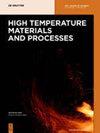喜马拉雅盐的高温熔融特性及其提纯
IF 1.5
4区 材料科学
Q4 MATERIALS SCIENCE, MULTIDISCIPLINARY
引用次数: 0
摘要
喜马拉雅岩盐含有多种矿物质和微量元素,有利于人体健康。黑色岩盐和玫瑰盐的溶液呈碱性,水不溶物含量分别为0.34%和0.083%。对岩盐中水不溶物的元素组成进行了测定和分析。研究发现,两种岩盐水不溶物的主要成分是土壤。由于岩盐中存在水不溶物,根据熔融氯化钠和不溶物的比重不同,采用高温熔融法提纯岩盐。玫瑰盐主要在纯化过程中进行研究。结果表明,在950℃保温40天后,玫瑰盐中不溶物的含量从0.083%下降到0.0024% min;砷、钡和铅的含量分别降至0.0032、0.61和0.21 mg·kg−1;钠含量增加到39.24%,钙、镁和铁含量分别达到2200855和1.31 mg·kg−1。本文章由计算机程序翻译,如有差异,请以英文原文为准。
Characteristics and purification of Himalayan salt by high temperature melting
Abstract Himalayan rock salt contains a variety of minerals and trace elements, which is conducive to human health. The solutions of black rock salt and rose salt are alkaline, and the content of water insoluble matter is 0.34 and 0.083%, respectively. The element composition of water insoluble matter in rock salt is determined and analyzed. It is found that the main component of two kinds of rock salt water insoluble matter is soil. Due to the presence of water insoluble matter in rock salt, according to the different specific gravity of molten sodium chloride and insoluble matter, rock salt was purified by high-temperature melting method. Rose salt is mainly studied during purification. The results showed that the content of insoluble matter in rose salt decreased from 0.083 to 0.0024% after holding at 950°C for 40 min; the contents of arsenic, barium, and lead decreased to 0.0032, 0.61, and 0.21 mg·kg−1, respectively; the content of sodium increased to 39.24%, the contents of calcium, magnesium, and iron reached to 2,200, 855, and 1.31 mg·kg−1, respectively.
求助全文
通过发布文献求助,成功后即可免费获取论文全文。
去求助
来源期刊

High Temperature Materials and Processes
工程技术-材料科学:综合
CiteScore
2.50
自引率
0.00%
发文量
42
审稿时长
3.9 months
期刊介绍:
High Temperature Materials and Processes offers an international publication forum for new ideas, insights and results related to high-temperature materials and processes in science and technology. The journal publishes original research papers and short communications addressing topics at the forefront of high-temperature materials research including processing of various materials at high temperatures. Occasionally, reviews of a specific topic are included. The journal also publishes special issues featuring ongoing research programs as well as symposia of high-temperature materials and processes, and other related research activities.
Emphasis is placed on the multi-disciplinary nature of high-temperature materials and processes for various materials in a variety of states. Such a nature of the journal will help readers who wish to become acquainted with related subjects by obtaining information of various aspects of high-temperature materials research. The increasing spread of information on these subjects will also help to shed light on relevant topics of high-temperature materials and processes outside of readers’ own core specialties.
 求助内容:
求助内容: 应助结果提醒方式:
应助结果提醒方式:


